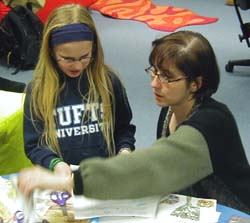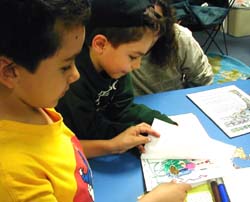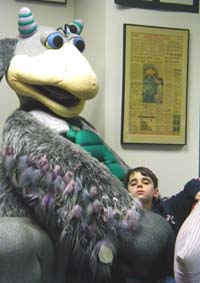| Maryland Newsline |
| Home Page |
Politics
|
|
Kids Partner with Adults to Conduct Research for Kids Research Pattern Spreading to Commercial TV, Toys
Maryland Newsline Tuesday, April 6, 2004 COLLEGE PARK, Md. - It’s 4:30 p.m., and eight University of Maryland academics are patiently waiting around a lab table for their top researchers to arrive. Or more specifically, to be dropped off by their parents. Tucked within the university’s computer science building is KidsTeam, a research group centered around six students between the ages of 7 and 11. The children partner with adults to design technologies that are just right for kids—a method that is slowly catching on with public and private research groups around the world. “It seems to be growing every year,” said KidsTeam Director Allison Druin, who founded the group in the university's Human-Computer Interaction Lab in 1998. While the community of collaborative kid’s research is still small, she said it’s big enough to draw respect from those who once called her plan radical. Pockets of kid researchers can be found around the world, particularly in North America and Europe, said Ben Williamson, a researcher at NESTA Futurelab, a group from the United Kingdom studying technology integration in education. Several university groups work with children throughout the design process, including researchers at the University of Tennessee, McGill University in Canada and Eindhoven University of Technology in The Netherlands, the researchers said. Commercial and nonprofit researchers at the Canadian Broadcasting Corp., PBS and Ragdoll Ltd. in the United Kingdom also employ kid researchers, spokesmen for the businesses said. As more successful projects and programs emerge, Williamson and others said, researchers will realize that children can be key players in an effective design process. Benefits to Working with Children
Zoe Jeka, Carl White, Jack Smith and Jonah Chazan plop down on fuzzy black pillows piled on carpet in the KidsTeam lab, which resembles a playroom. But innovative computer projects, like digital story tellers and digital libraries, are designed here. KidPad, one of the earliest projects developed, allows children to draw pictures and design stories on computers. Another project, the International Children’s Digital Library, is the world’s first digital compilation of more than 300 children’s books. The library was launched online in 2000.Involving kids from the start makes a project more likely to succeed, Druin said. Since children design the projects, they’re more likely to serve their peers and sustain their levels of interest. “Kids bring perspectives adults can’t bring,” said Andy Large, professor of information studies from Canada’s McGill University. Large ran a research program similar to Druin’s that had a group of third graders and a group of sixth graders each design a Web search engine—designs the adults never dreamed of, he said. The sites, KidSearch Canada and History Trek, are still being tested before launch. In the long-run, kid-driven research is more effective, researchers say. A 2002 study on children’s interactive media by market research company Just Kid Inc. reported that many children’s toy products failed because companies focused too much on new technology and not enough on kids’ needs. The Connecticut-based group found that “almost no product research [was] being conducted with children to inform product design.” Many products fail because they do not have children test them until the very end, said Alissa Antle, former executive producer and creative director of the Canadian Broadcasting Corp.’s project to revamp its children’s Web site. The site's design was almost complete before kids were brought in to test it. Designers discovered the kids couldn’t figure out how to log in, she said. However, major companies like Mattel and Hasbro have succeeded even though most of their research with children is limited to using them as observation subjects, interviewees in focus groups and product testers. Only about 5 percent to 10 percent of major companies employ kids as designers, said Wynne Tryee, director of insights for Just Kid Inc., which conducts market research for Hasbro and other companies. Hasbro does not co-design with children, said company spokeswoman Audrey DeSimone, but its kids’ lab invites children to test out its products. Not all Fun and Games: Challenges to Designing with Kids
Involving children in the research process is not always feasible for research groups and companies that are tight on resources, said Antle. Such research demands streams of money to maintain long-term labs with kids. It also means finding professionals willing to collaborate with children. Working with kids also means taking more time for research. “It is less efficient,” Druin agreed. “Kids get sick, they have homework -- you have to give them snacks.” However, once KidsTeam generates usable design ideas, then “I can focus my energies, and then I set loose expensive programmers,” she said. Children can force adults to test their imaginations, but some suggestions, like toys that finish homework, need to pass through an adult filter, Tryee said. , founder of Skybluepink Interaction Design, agreed that having children as designers has its limitations. “You can’t ask a four year old to design the cell phone of the future!” she wrote.History of Kid-Driven Designs While Druin’s partnership with children is rare, the concept is hardly new. Sesame Street made its debut in the 1970s as one of the first TV programs with an educational mission and became one of the first groups to host informative research sessions with day care centers. Most children’s TV programs back then “didn’t have to prove something, but we had a clear educational mission so we had to figure out whether they [the programs] were succeeding,” said Cornelia Brunner, one of the early researchers with Sesame Street and now an associate director at the Center for Children and Technology, a nonprofit that researches classroom technology. Child research has been a core component for many years of the creative process of the United Kingdom’s Ragdoll Ltd., the TV production company that created Teletubbies. “It does seem that other children’s TV companies are starting to realise [sic] the value after the much publicised [sic] role it played in the huge success of Teletubbies,” wrote Branton, who was also a former interaction designer at Ragdoll.
Future of this research While the number of groups collaborating with child researchers is still small, it will continue to grow, Tryee said. “The more power and influence kids continue to have, which is the way the market is going, and the more money [parents] have in their pockets, the more people are going to care what kids think or not,” she said. Nine-year-old Zoe agrees. “It’s important for kids to design the technology, because only kids know what kids want,.” she said. Plus, “This isn’t like homework at all, it’s research that’s fun… and our inventions are already all over the world,” she said. With any luck, such collaborative research will provide better technology for children in the future, Druin said. "Kids don’t have to wait ’til they’re 18 to change the world— they can change it when they’re short,” she said. Copyright © 2004 University of Maryland Philip Merrill College of Journalism |




